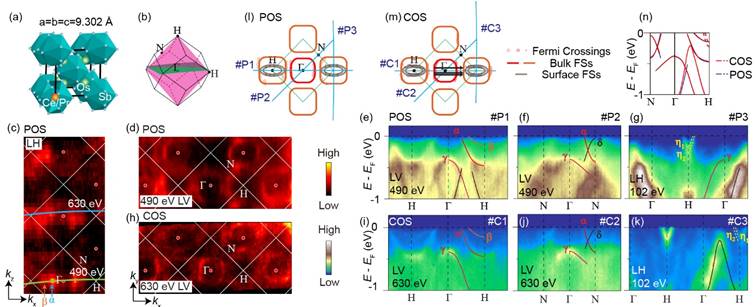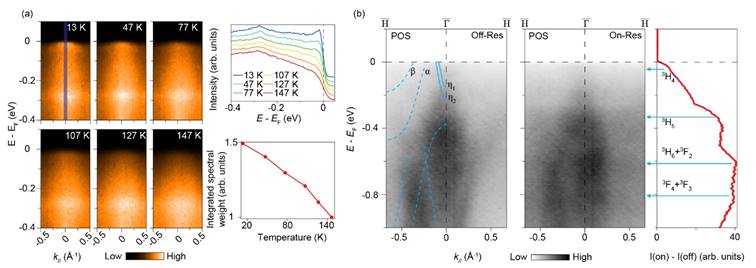具有4f1电子构型的重费米子材料已经获得了广泛的研究,例如其中的c-f杂化及其变温行为很好地解释了低温下比热系数的异常。然而,不同于4f1电子构型材料,对4f2电子构型材料的研究非常匮乏,尚没有对其微观电子行为的系统性实验研究。Kondo杂化行为在4f1、4f2电子构型材料中会有什么区别?这个依然是个亟待解决的问题。
填充型方钴矿结构材料CeOs4Sb12、PrOs4Sb12为这一研究方向提供了理想的平台:具备4f1电子构型的COS存在Kondo杂化导致的绝缘体转变,而具备4f2电子构型的POS是一个重费米子超导体。通过角分辨光电子能谱(ARPES)研究,我们揭示了这一区别的微观起源。二者在eV尺度上的电子结构相似[Fig. 1],反映了ROs4Sb12(R =稀土元素)系统的共性。然而,导带电子和f电子的杂化差异明显。在COS中我们观察到了导带电子和f电子的强烈杂化以及因此产生的能带依赖的能隙,并通过变温实验直接观测了Kondo绝缘态的形成[Fig. 2(a)]。虽然4f2电子构型的基态亦是带磁性的自旋单态,POS中导带电子和f电子的杂化显得强度有限且非相干[Fig. 2(b)]。该现象可以通过由热激发产生的非磁性自旋三态的Kondo散射理解。我们的结果不仅推动了对COS和POS迥异物性的研究,而且为理解4f1、4f2电子构型重费米子材料提供了清晰的微观图像。

Fig. 1: CeOs4Sb12、PrOs4Sb12的电子结构。

Fig. 2: CeOs4Sb12的共振变温结果、PrOs4Sb12的共振和非共振结果对比。
论文见:X. Lou, T. L. Yu, Y. H. Song, C. H. P. Wen, W. Z. Wei, A. Leithe-Jasper, Z. F. Ding, L. Shu, S. Kirchner, H. C. Xu, R. Peng, and D. L. Feng, Distinct Kondo Screening Behaviors in Heavy Fermion Filled Skutterudites with 4f1and 4f2Configurations, Physical Review Letters 126.13 (2021): 136402
Distinct Kondo Screening Behaviors in Heavy Fermion Filled Skutterudites with 4f1and 4f2Configurations
Materials with 4f1configuration has been widely studied, in whichc-fhybridization and its temperature-dependence behavior provides a good explanation on the anomaly of heat capacity at low temperature. In the meanwhile, even systematic experiments on the microscopic electronic behavior of 4f2systems are scarce. The key problem on how the Kondo hybridization varies from 4f1to 4f2systems is yet to be settled.
CeOs4Sb12 (COS) and PrOs4Sb12 (POS) with filled-skutterudite structure are two representative compounds that provide the ideal vantage point to systematically study the physics of multi-f-electron systems. COS with Ce 4f1, and POS with Pr 4f2configurations show distinct properties of Kondo insulating and heavy fermion superconductivity, respectively. Through angle-resolved photoemission spectroscopy (ARPES) studies on COS and POS, we unveiled the underlying microscopic origin. Their eV-scale band structure matches well [Fig. 1], representing the common characters of conduction electrons in ROs4Sb12systems (R = rare earth). However,felectrons interact differently with conduction electrons in COS and POS. Strong hybridization between conduction electrons andfelectrons is observed in COS with band dependent hybridization gaps, and the development of a Kondo insulating state is directly revealed [Fig. 2(a)]. Although the ground state of POS is a singlet, finite but incoherent hybridization exists [Fig. 2(b)], which can be explained by the Kondo scattering with the thermally excited triplet crystalline electric field state. These results help to understand the intriguing properties in COS and POS, and provide a clean demonstration of the microscopic differences in heavy fermion systems with 4f1and 4f2configurations.

Fig. 1: Electronic structure of CeOs4Sb12and PrOs4Sb12.

Fig. 2: Temperature-dependence result with resonant photo energy of CeOs4Sb12and the comparison between on-resonance and off-resonance result of PrOs4Sb12.
Reference:X. Lou, T. L. Yu, Y. H. Song, C. H. P. Wen, W. Z. Wei, A. Leithe-Jasper, Z. F. Ding, L. Shu, S. Kirchner, H. C. Xu, R. Peng, and D. L. Feng, Distinct Kondo Screening Behaviors in Heavy Fermion Filled Skutterudites with 4f1and 4f2Configurations, Physical Review Letters 126.13 (2021): 136402